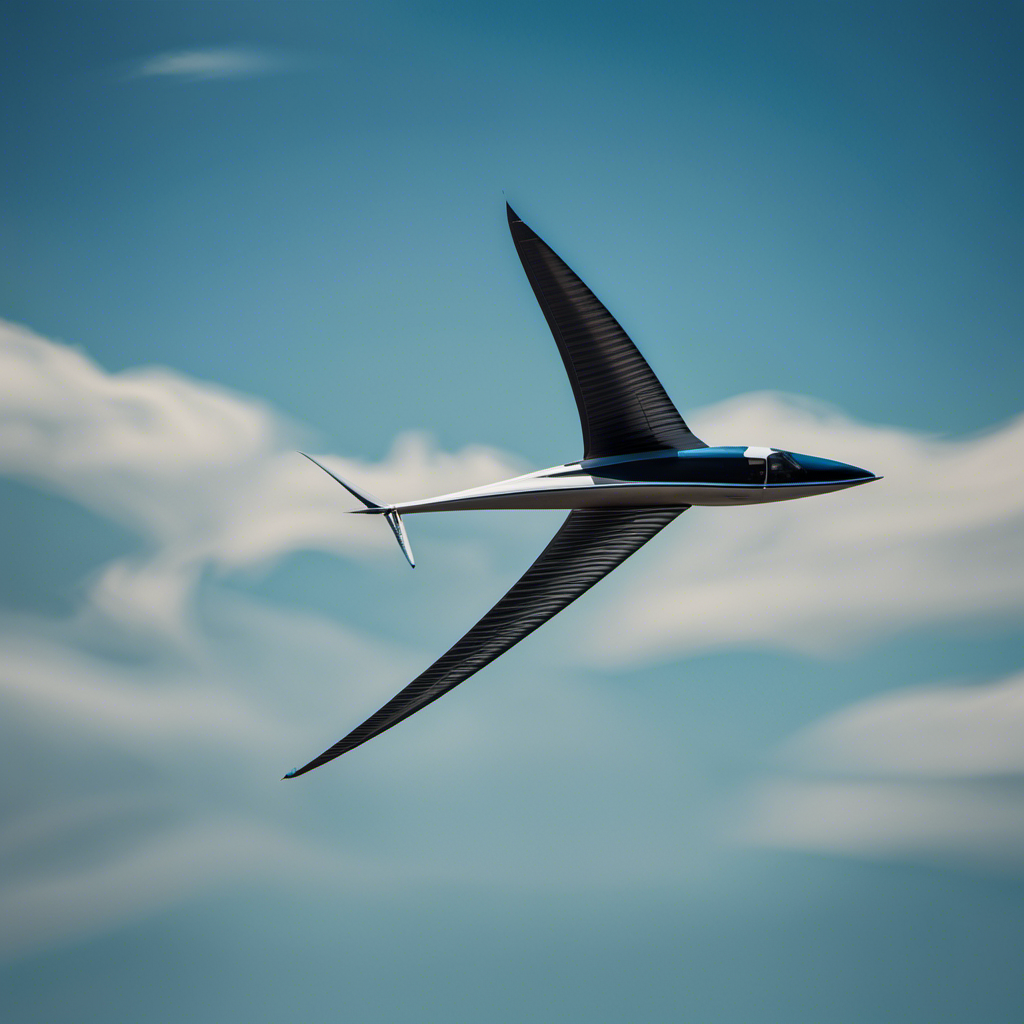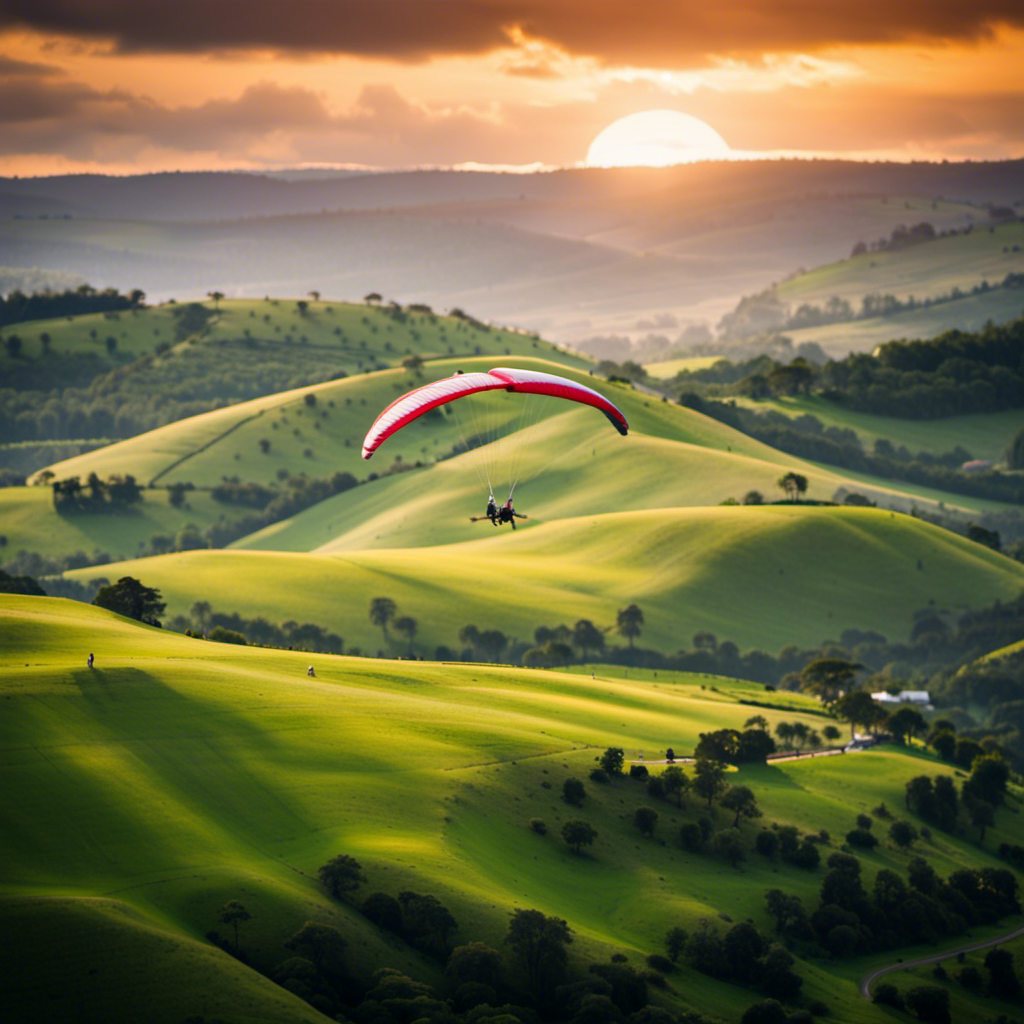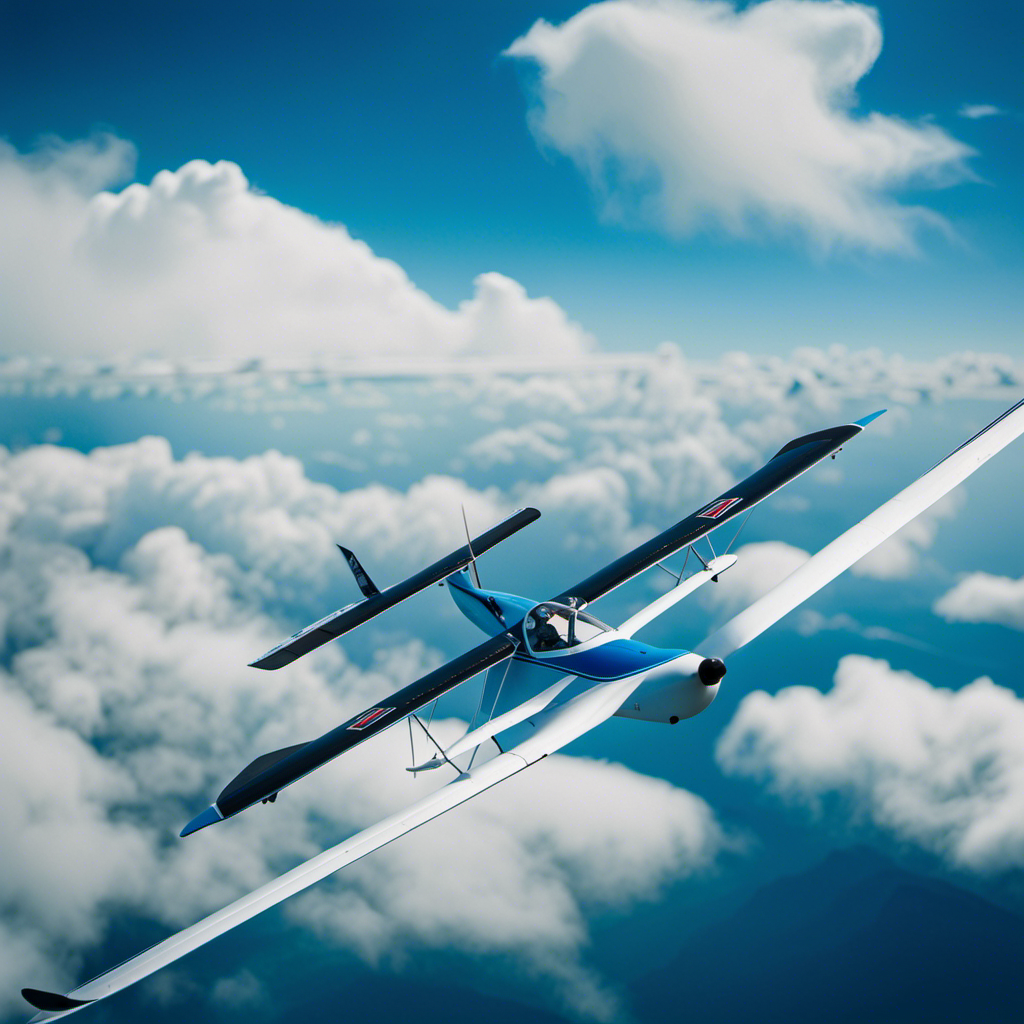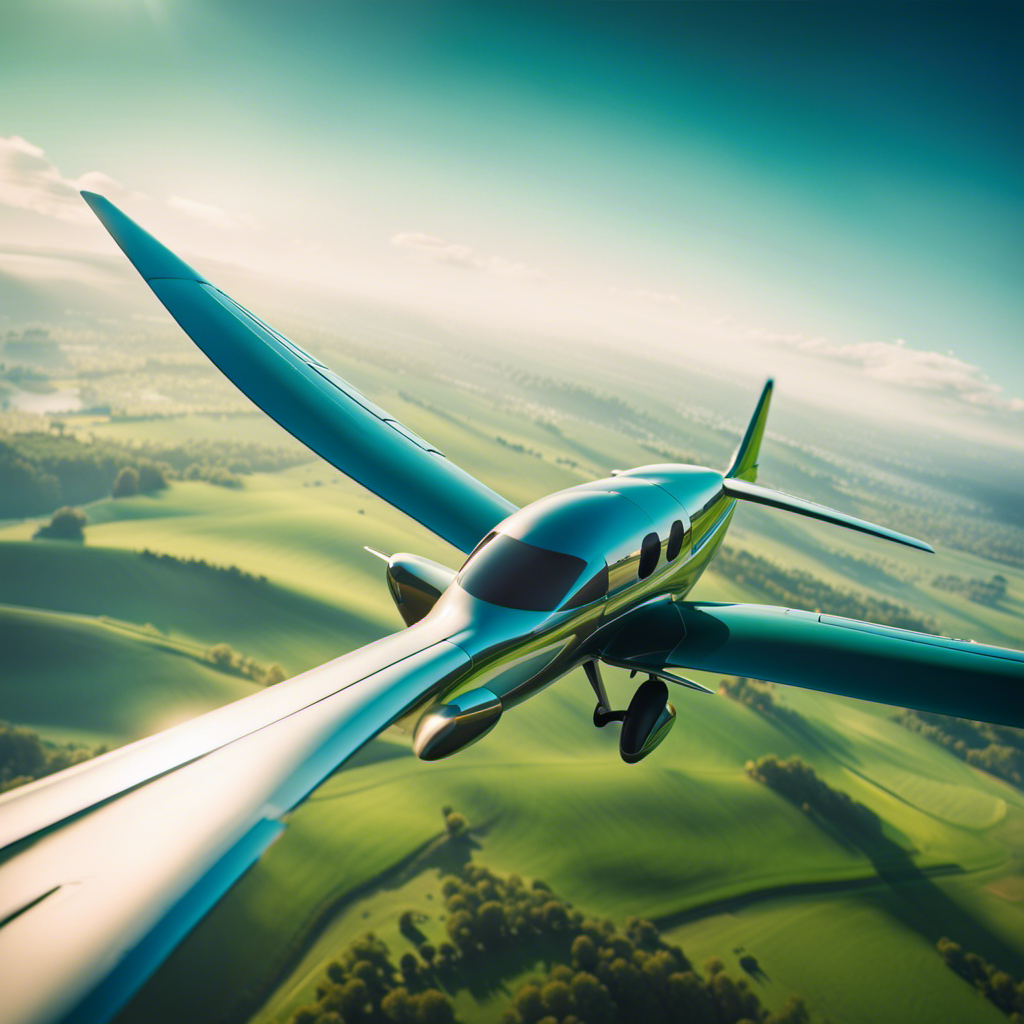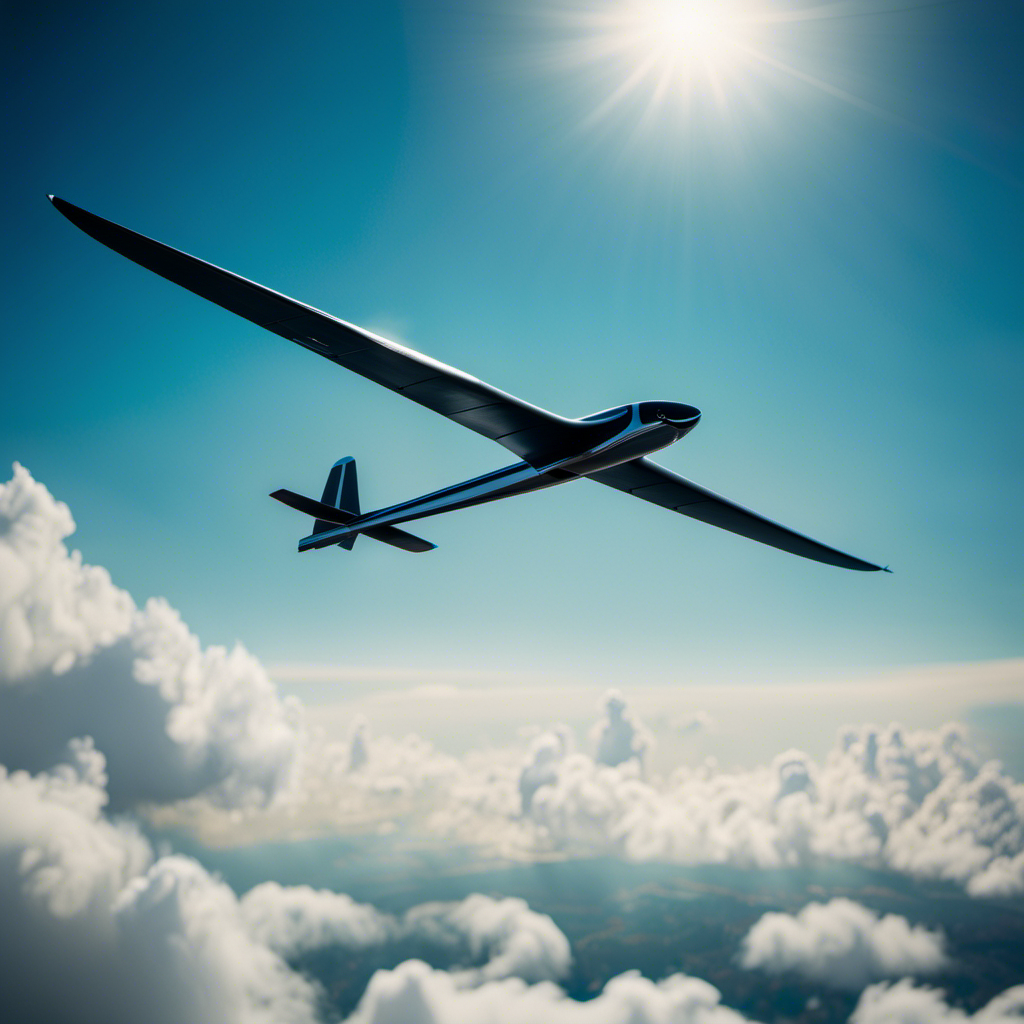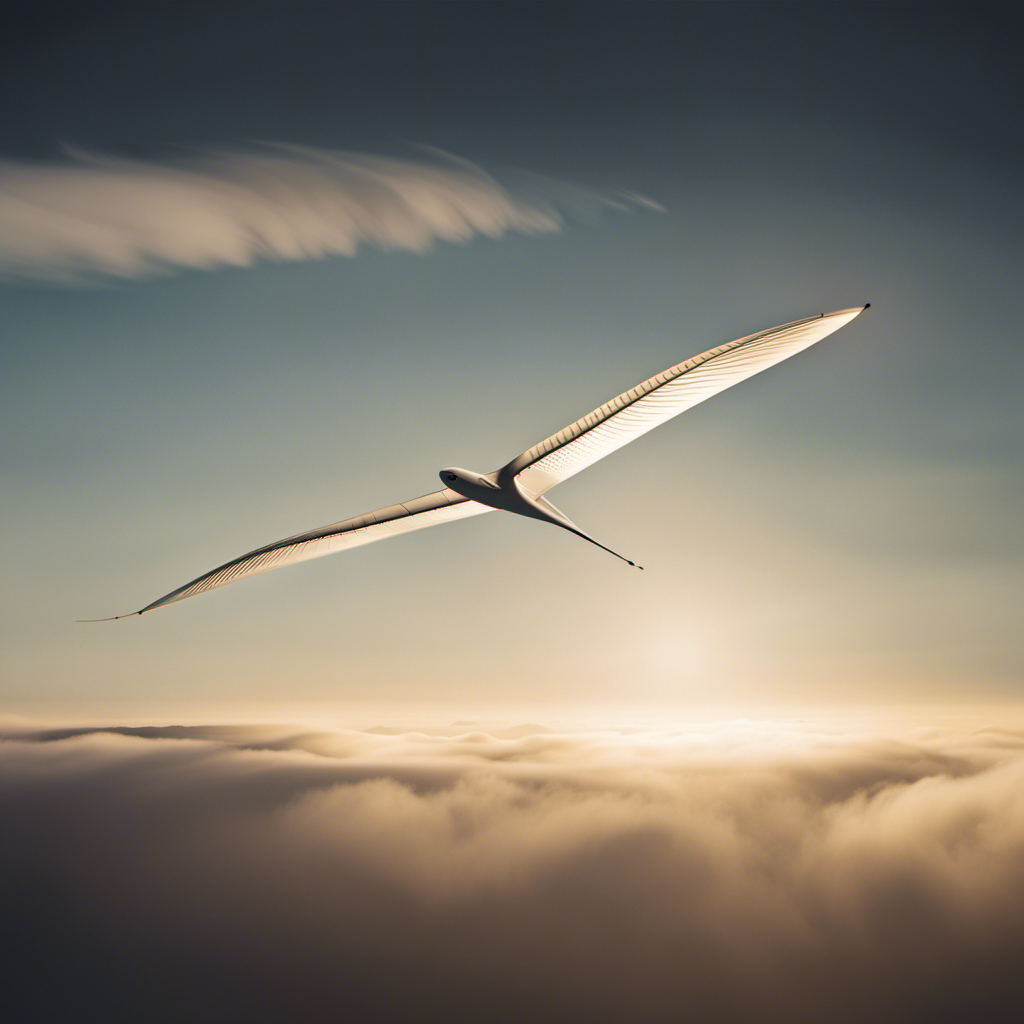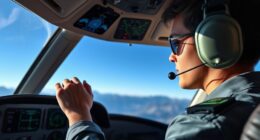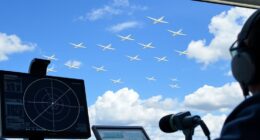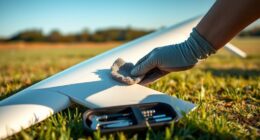As a glider pilot, I have always been fascinated by the impressive ability of these aircraft to stay in the air for extended periods of time. It’s almost like they have unlocked the secret to defying gravity. But what is it that makes them so extraordinary?
In this article, we will delve into the intricate mechanics of glider flight, exploring the role of lift, airflow, thermals, and pilot skill. We’ll also examine the impact of weather conditions and advancements in glider technology.
So, fasten your seatbelts and prepare for an exhilarating journey into the world of gliding.
Key Takeaways
- Glider wings generate lift and minimize drag through their airfoil shape and winglets, which reduce wingtip vortices.
- Weather conditions, such as wind patterns, atmospheric pressure, and thermals, greatly impact glider flight duration.
- Pilot skill and technique play a significant role in extending flight time by effectively navigating wind patterns and exploiting lift sources.
- Advancements in glider technology, including electric propulsion systems, energy storage, aerodynamic enhancements, and autonomous flight capabilities, contribute to longer and more efficient flights.
Understanding the Basics of Glider Flight
To understand how gliders fly for so long, you need to grasp the basics of glider flight.
Glider performance is dependent on the aerodynamic principles governing its flight. The key to sustaining flight in a glider lies in its ability to generate and maintain lift.
Lift is generated by the shape of the wings, which are designed to create a pressure difference between the top and bottom surfaces. This pressure difference creates an upward force that counteracts the force of gravity, allowing the glider to stay aloft.
In addition to lift, the glider’s performance is also influenced by factors such as its weight, airspeed, and angle of attack. Understanding these principles lays the foundation for comprehending the role of lift and airflow in gliding.
The Role of Lift and Airflow in Gliding
Understand how lift and airflow work together to keep you gliding effortlessly through the air.
Lift is the force that counteracts gravity and allows a glider to stay aloft. It is generated by the shape of the glider’s wings, called airfoils, which are specifically designed to produce lift.
As air flows over the curved upper surface of the wing, it moves faster and creates lower pressure, while the air beneath the wing moves slower and creates higher pressure. This pressure difference creates an upward force, lifting the glider.
The airflow over the wings is crucial for generating lift, and the glider pilot must carefully control the angle of attack and the speed of the glider to maintain optimal airflow and maximize lift.
Understanding the role of lift and airflow is essential to understanding how gliders use thermals and updrafts to stay aloft.
How Gliders Use Thermals and Updrafts to Stay Aloft
Take advantage of thermals and updrafts to effortlessly stay aloft while gliding through the air. Thermals and updrafts are both natural phenomena that provide gliders with the necessary lift to maintain flight. However, they differ in their origin and characteristics.
Thermals are columns of warm air that rise from the Earth’s surface due to uneven heating. Glider pilots can use thermals to gain altitude by circling within the thermal and ascending with the rising warm air. On the other hand, updrafts are created by the wind encountering an obstacle, such as a hill or a mountain. Gliders can utilize updrafts by flying along the slope or ridge, which generates an upward force that sustains their flight.
To better understand the differences between thermals and updrafts, refer to the table below:
| Thermals | Updrafts |
|---|---|
| Origin: | Origin: |
| Uneven heating of the Earth’s surface | Wind encountering an obstacle |
| Characteristics: | Characteristics: |
| Rising columns of warm air | Upward force along a slope or ridge |
By effectively utilizing these glider flight techniques, pilots can stay airborne for longer periods and cover greater distances. In the next section, we will explore the principles of glide ratio and efficiency, which further contribute to extended flight times.
Exploring the principles of glide ratio and efficiency allows glider pilots to optimize their performance and maximize their time in the air.
Exploring the Principles of Glide Ratio and Efficiency
Exploring the principles of glide ratio and efficiency helps glider pilots optimize their performance and make the most of their time in the air. By understanding how to maximize glide ratio and reduce drag, pilots can extend their flight duration and cover more distance. Here are four key factors to consider for glide ratio optimization and drag reduction:
-
Wing design: A well-designed wing with a high aspect ratio and low drag profile can significantly improve glide performance.
-
Airspeed control: Maintaining the optimal airspeed for a given glider helps minimize drag and maximize the glide ratio.
-
Trim settings: Adjusting the glider’s trim settings allows pilots to find the most efficient balance between lift and drag.
-
Aircraft cleanliness: Keeping the glider’s surfaces clean and smooth reduces parasitic drag, enhancing overall performance.
Understanding these principles can lead to better glide performance and help pilots stay airborne for longer periods.
Now let’s delve into the importance of weight and balance in glider design.
The Importance of Weight and Balance in Glider Design
To optimize your glider’s performance, it’s crucial to maintain proper weight and balance throughout its design. Weight distribution plays a critical role in the aerodynamic efficiency of the glider. The distribution of weight affects the glider’s stability and its ability to maintain a steady glide.
A well-balanced glider will have its center of gravity positioned correctly, ensuring that it remains in a stable and controlled flight path. Additionally, weight distribution impacts the glider’s ability to maneuver and respond to control inputs effectively. By carefully considering the weight distribution during the design process, engineers can create a glider that maximizes its potential for long and efficient flights.
Now, let’s delve into the role of control surfaces in maneuvering and stability.
The Role of Control Surfaces in Maneuvering and Stability
Make sure you understand how control surfaces affect maneuvering and stability in your glider. Control surface design plays a crucial role in achieving aerodynamic stability and control during flight.
Here are three key aspects to consider:
-
Elevators: These control surfaces, located on the horizontal stabilizer, control the pitch of the glider. By changing the elevator position, you can adjust the nose-up or nose-down attitude, which affects the glider’s climb or descent.
-
Ailerons: Found on the trailing edge of the wings, ailerons control the roll of the glider. When one aileron moves up and the other down, the glider rolls in the desired direction.
-
Rudder: The rudder, usually located on the vertical stabilizer, controls the yaw of the glider. By deflecting the rudder, you can make the glider turn left or right.
Understanding how these control surfaces work together is essential for achieving precise maneuvering and maintaining stability in your glider.
Now, let’s delve into the science behind glider wings and wingtip vortices.
The Science Behind Glider Wings and Wingtip Vortices
Understanding how control surfaces work together is essential for achieving precise maneuvering and maintaining stability in your glider.
When it comes to glider wing design, the aerodynamics of gliding play a crucial role in sustaining flight. Glider wings are designed to generate lift and minimize drag, allowing the glider to stay aloft for extended periods. The shape of the wings, known as the airfoil, is carefully designed to optimize lift and reduce drag.
Additionally, glider wings often feature winglets or wingtip devices, which help to reduce wingtip vortices. These vortices are created by the pressure difference between the upper and lower surfaces of the wings and can cause drag. By reducing wingtip vortices, glider wings can achieve greater efficiency and longer flight durations.
Transitioning into the subsequent section about the influence of weather conditions on glider flight, it is important to consider how these factors can impact the overall performance and duration of a glider flight.
The Influence of Weather Conditions on Glider Flight
Be aware that weather conditions have a significant impact on how long you can stay aloft in your glider. The influence of wind patterns and the impact of atmospheric pressure play a crucial role in determining the duration of your flight.
Wind patterns, such as thermals and ridge lift, can provide the necessary lift to keep the glider airborne for extended periods. By understanding these patterns and utilizing them effectively, pilots can maximize their flight time.
Furthermore, atmospheric pressure affects the glider’s performance by influencing air density and stability. Changes in pressure can create updrafts or downdrafts, which can either assist or hinder the glider’s ability to sustain flight. Therefore, being able to interpret and adapt to changing weather conditions is essential for prolonging your time in the air.
Moving on to the role of pilot skill and technique in extending flight time…
The Role of Pilot Skill and Technique in Extending Flight Time
In analyzing the influence of weather conditions on glider flight, it is essential to consider the role of pilot skill and technique in extending flight time.
The pilot experience and their ability to navigate wind patterns effectively are crucial factors that contribute to the longevity of glider flights. Experienced pilots possess a deep understanding of aerodynamics and can make precise adjustments to optimize their glider’s performance in varying wind conditions.
They can anticipate changes in wind patterns and exploit thermals, ridges, and wave lift to gain altitude and extend their flight. By carefully reading the atmosphere and making strategic decisions, skilled pilots can maximize their flight time and cover great distances.
These skilled techniques in piloting are essential to exploit the natural forces at play and achieve extended flight durations.
Transitioning into advancements in glider technology and future possibilities, it is clear that pilot skill, coupled with technological innovations, holds immense potential for even longer and more efficient glider flights.
Advancements in Glider Technology and Future Possibilities
With advancements in glider technology, pilots can now leverage innovative features to achieve even longer and more efficient flights. These advancements have primarily focused on improving propulsion technology, which plays a crucial role in extending flight time.
Here are four key advancements in glider technology that have the potential to revolutionize long duration flight:
-
Electric propulsion systems: Electric motors powered by batteries or solar panels offer a sustainable and quiet alternative to traditional propulsion methods, allowing gliders to remain airborne for extended periods without relying on thermal or wind conditions.
-
Energy storage systems: Advanced energy storage systems, such as high-capacity batteries, enable gliders to store excess energy during periods of high performance and use it during low-performance phases, thereby increasing overall flight duration.
-
Aerodynamic enhancements: Improved wing designs, including laminar flow profiles and winglets, reduce drag and enhance lift, enabling gliders to achieve higher speeds and cover greater distances with the same amount of energy.
-
Autonomous flight capabilities: With the integration of sophisticated autopilot systems and artificial intelligence, gliders can now autonomously optimize their flight path, energy usage, and thermal soaring techniques, leading to more efficient and prolonged flights.
These advancements in glider technology open up exciting possibilities for various applications, including scientific research, aerial surveillance, environmental monitoring, and even long-duration recreational flights.
Frequently Asked Questions
How do gliders land safely without an engine?
Glider landing techniques involve careful control of airspeed, angle of descent, and timing to ensure a safe touchdown without an engine. Pilot skill is crucial in executing these maneuvers with precision and minimizing the risk of accidents.
What are the different types of thermals and how do gliders utilize them?
Different techniques, equipment, and strategies used in gliding competitions include flying different types of thermals. Gliders utilize thermals by circling within them, using the upward currents of warm air to gain altitude and extend their flight time. Meteorology plays a crucial role in identifying and predicting the presence of thermals.
How does the weight and balance of a glider affect its flight performance?
Weight and balance considerations in glider design are crucial for optimal flight performance. By carefully distributing weight and adjusting the center of gravity, gliders can efficiently utilize air currents, such as thermals, to sustain flight for extended periods.
What are the main control surfaces on a glider and how do they work together for maneuvering and stability?
The control surfaces on a glider, such as the ailerons, elevator, and rudder, work together to manipulate aerodynamic forces for maneuvering and stability. These surfaces allow precise control over pitch, roll, and yaw.
How do weather conditions such as wind speed and direction affect glider flight?
Weather conditions, such as wind speed and direction, have a significant impact on glider flight. Atmospheric pressure affects lift and the glider’s ability to maintain altitude, while wind shear can affect performance and stability during maneuvers.
Conclusion
In conclusion, the ability of gliders to fly for extended periods of time is a result of various factors working together in harmony. By leveraging lift and airflow, gliders can maintain altitude and glide through the air with minimal energy expenditure.
One interesting statistic to note is that the glide ratio of a typical glider can range from 25:1 to 60:1, meaning that for every unit of altitude lost, the glider can travel 25 to 60 units horizontally. This high efficiency is crucial for maximizing flight time and distance covered.
With advancements in glider technology, the future holds even greater possibilities for prolonged glider flight.
